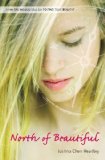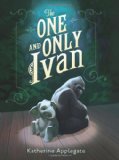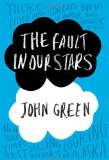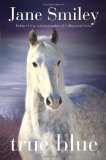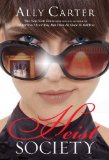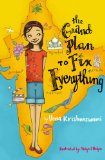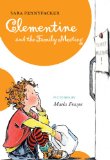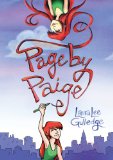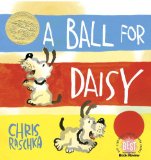Review of North of Beautiful, by Justina Chen Headley
by Justina Chen Headley
Little, Brown and Company, New York, 2009. 373 pages.
I read this book on the flight home from KidLitCon 2011, having just heard the author speak as part of an insightful and thought-provoking panel on diversity, and having gotten the book signed. In the panel, Justina Chen said that she didn’t want to get categorized as a writer who wrote only Chinese characters, so she purposely made this character blonde and classically beautiful — with one exception. Here’s how the book begins:
“Not to brag or anything, but if you saw me from behind, you’d probably think I was perfect. I’m tall, but not too tall, with a ballerina’s long legs and longish neck. My hair is naturally platinum blond, the kind that curls when I want it to and cascades behind my back in one sleek line when I don’t. While my face couldn’t launch a thousand ships, it has the power to make any stranger whip around for a second look. Trust me, this mixture of curiosity and revulsion is nothing Helen of Troy would ever have encountered.
“Please don’t get me wrong; I’ve got all the requisite parts — and in all the right numbers, too: one nose, two eyes, and twenty-four teeth that add up to not a bad smile. But who notices pearly whites when a red-stained birthmark stretches across the broad plain of my right cheek? That’s exactly why I never went anywhere without my usual geologic strata of moisturizer, sunblock, medical concealer, foundation, and powder.”
Terra Rose Cooper is named after mapping terms and has a fascination for maps, like her father, the famous cartographer. She’s got a good-looking boyfriend who’s on the wrestling team, but she’s not sure he even really sees her or cares about her more than for sleeping with her. An interfering visiting professor puts a brochure in her hands about a new technique that could eliminate her birthmark. Should she try it?
Her Dad has said he won’t spend another penny on her face. She’d already tried so many things that didn’t work. She never even gets a chance to talk with her boyfriend about it. She does it during Christmas Break, so no one will see her while she’s healing.
But then, driving back from the first procedure with her mother (without telling her father), her car slides on black ice and she has an accident. She almost hits a boy about her age, dressed all in black. That boy, Jacob, has a scar on his own face. He was born in China with a cleft palate and was adopted by his mother Norah (who owns the car she hit) and brought to America.
Meanwhile, Terra’s applying for early entrance to college. She wants to escape from her family, and her emotionally abusive father, as her older brothers have done. One of them moved to China, and he sends tickets to Terra and her mother, telling them to come visit. Terra doesn’t think her mother would ever be brave enough.
One thing leads to another. After Norah and Jacob drive Terra and her mother home, Norah and Terra’s mother hit it off. So Terra sees more of Jacob. Then Norah talks them into traveling to China together, where Terra’s going to see much more of Jacob. But what about her boyfriend?
This book is full of mapping metaphors and symbolism — almost too many. Terra is an artist, who works with collages and employs many map fragments and symbols. She’s working on a “Beauty Map” about what the world thinks is beautiful. Jacob teaches her to geocache, which of course involves more navigational terms. Her Dad is presented as a famous cartographer whose career was ruined when he supported a map alleged to be by a Chinese navigator who discovered America before Columbus. That map was later proved to be a fraud, and that destroyed her father’s career and is why he moved to a town in the middle of nowhere.
That didn’t ring quite true for me. I wasn’t sure what kind of job a cartographer would even find in an isolated town. And how could something like that mess up his career? But then I was really brought up short by this paragraph:
“Dad’s work was purely high-tech, coding the software for global positioning systems, first for the military back in the eighties and then spinning off to do consulting work for software mapping companies.”
That didn’t ring true for me at all, because my Dad was instrumental in developing software for global positioning systems way before the eighties. And he is no cartographer; he’s an engineer. I’m sure that cartographers use GPS now that it’s been developed, but when my Dad first worked with satellite navigation, they were mostly used on ships, not by mapmakers. I could be wrong, but I’m pretty sure cartographers didn’t have much to do with developing the software for global positioning systems.
But that’s a piddly detail that I wouldn’t expect anyone else to notice. The author’s story did give us an explanation for why Terra’s Dad was so bitter and resentful and abusive, and especially angry at China. She was pretty vague about what the father actually did, so it felt just a little bit of a clunky way of pulling the map metaphor into the plot.
However, I have to say that the metaphor worked well. After all, Terra was thinking about her life’s path and what constitutes True Beauty.
And by the time I finished, I was impressed by how it was all woven together. It’s tricky to write a good story of someone dealing with emotional abuse, and this one pulled it off well. It’s not only Terra who’s learning to respect herself and stand up for herself; we also see her Mom coming into her own, especially on the China trip with Norah. It happens gradually, in realistic little steps. And it doesn’t end with a neat tie-up. We see that progress has been made, and things could go either way. I thought that whole aspect was masterfully done.
So this is an intriguing read, with lots to think about: true beauty, dealing with subtle emotional abuse, even sibling relationships. And the story is intriguing as well, with nicely done romance.
Find this review on Sonderbooks at: www.sonderbooks.com/Teens/north_of_beautiful.html
Disclosure: I am an Amazon Affiliate, and will earn a small percentage if you order a book on Amazon after clicking through from my site.
Source: This review is based on my own book, purchased at KidLitCon and signed by the author.
